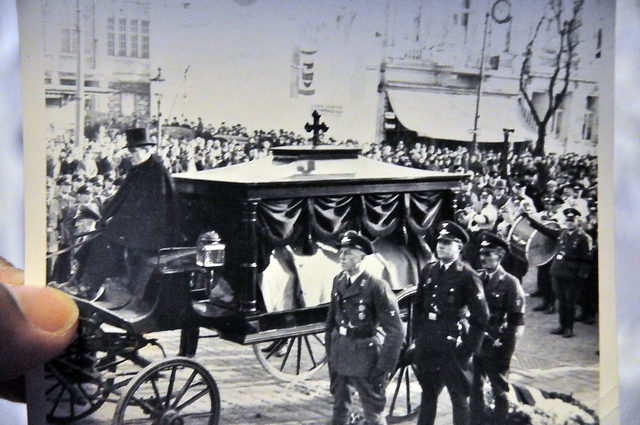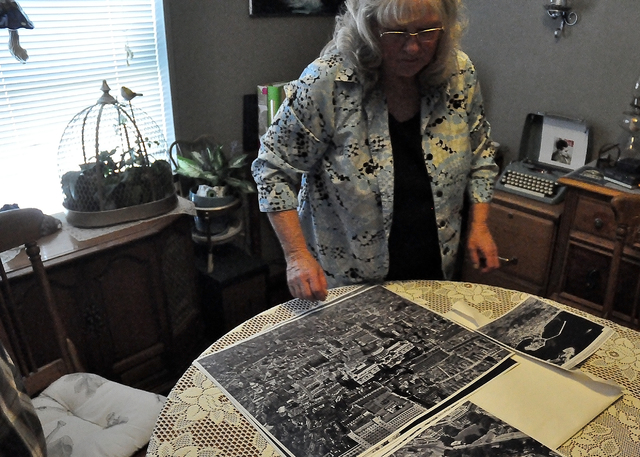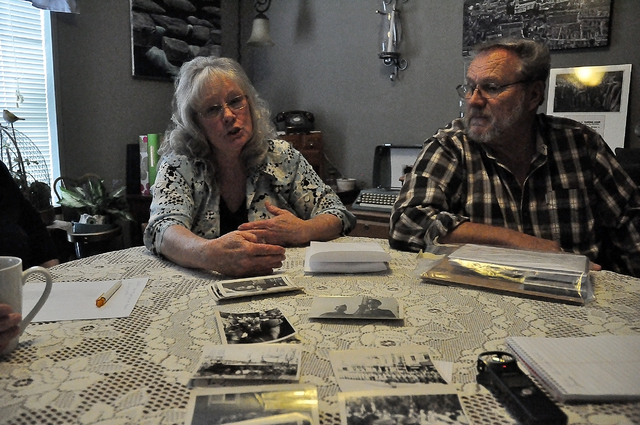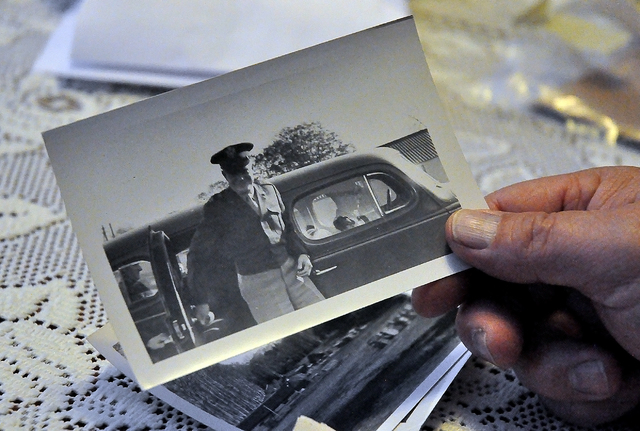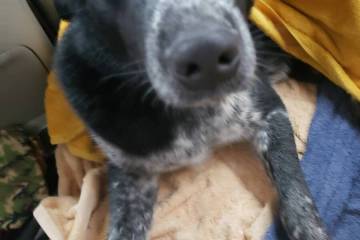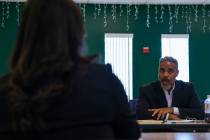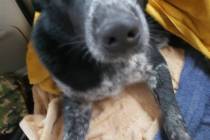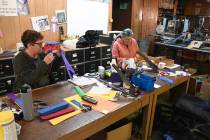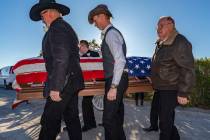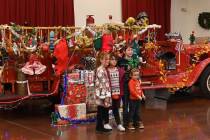Declassified World War II photos remain family mystery
It’s a family mystery that has eluded his family for 72 years and now that he is on the verge of retirement, Frank Eberflus Jr., hopes to get the answers to his questions.
For the past seven years, Frank Eberflus Jr. has been working to unravel the mystery of his father’s service during World War II. Frank Eberflus Sr. was a veteran and passed away in 1982.
Didn’t his father talk about the war?
“My father never told us much about the war, let alone what he did,” Frank Eberflus Jr. said. “So that’s the mystery. What did my dad do in the service? Most vets of that war don’t talk about World War II.”
All he knows is that his father worked for the Office of Strategic Services (OSS), which was the intelligence gathering service for the United States during the war and later in 1948 it became the Central Intelligence Agency.
And he knows this for several reasons.
“We got a clue from photos that he was not in uniform, which was common for OSS people,” Frank Jr. said. “Also some photos appeared to be taken as from cover. He also had OSS on his ID card and finally, he was inducted into the Army and by war’s end he was out through the Navy.”
Throughout the war, Frank Eberflus Sr. collected photographs wherever he went, something a lot of soldiers in the war did, but unlike the other soldiers, Frank Sr. was a photographer himself and kept the negatives.
“He took a lot of photos and I have a picture of him during the war developing photos,” Frank Jr. said. That is one of the things he knows his father did do.
He knows this because growing up he said his father was proud of a collection of photographs, some 30 spectacular aerial shots of Europe that he carefully wrapped in newspaper and would only show to friends and family.
“He would take the photos out and show us but he would tell us never to talk to anyone about them, and we didn’t,” Frank Jr. said.
“There is a shot of the Tower of London and if you look closely you can see some bodies piled along one of the walls of the tower,” Frank Jr.’s wife, Carol Eberflus said. “The photo of St. Paul’s Cathedral shows the bombed-out sections around the church.”
“I know he was strapped to an airplane and took these aerial photographs,” Frank Jr. said. “I had a friend in the Navy that said, ‘You know your dad was strapped to a plane wing when he took these.’ I was also told this by other people too.”
In addition to the aerial photos, there were also some 200 photos with negatives that he kept in boxes.
In that collection, he even has pictures of Nazi soldiers at a funeral. How were those photos taken and why? And who took them? Frank Jr. assumes his father did, but if he did, he had to go behind enemy lines. He’s not sure he did that.
“One of particular interest is a photo of an OSS office and the photo shows a clipboard with a note that says, ‘Get our boys out of the salt mines’,” Leise Peterson, a family friend working to help solve the mystery said. “Could that be the operatives working to keep the Nazis from destroying the stolen art they had hidden away in the mines?”
And then there is the photo of General Dwight Eisenhower, commander in chief of the Allied forces during the war. Who took that one and why?
Really all Frank Eberflus Jr. knows for sure is his father drove a truck prior to the war and was then trained as a technician for the OSS and he knows he did some photographic work. That is the extent of it.
Frank Jr. hopes to clear most of this up through government records.
“We expect to hear from the government soon,” he said. “We hope his service records will tell us where he went.”
Mark Hall-Patton, museum administrator of the Clark County Museum system, said it was rare for OSS guys to take photos behind enemy lines because if you were caught with the camera it was death.
“A lot of photos were picked up by soldiers as souvenirs,” Hall-Patton said. “So if a soldier knew a photographer he could get photographs or copies of a photo as a favor.”
Hall-Patton said that there was a regulation in World War II that prohibited soldiers from taking their own photos.
“The military was afraid that the soldiers might disclose troop movements or highly-classified photos,” Hall-Patton said. “So many soldiers got around this by trading photos and by doing favors for photos.”
On the records the Eberflus’ are expecting from the government, Hall-Patton said they shouldn’t expect much.
“These people will be disappointed,” he said. “They will not get all their questions answered and if they think they will get a detailed report, they won’t.”
According to Hall-Patton, OSS missions were highly secretive and most of the records were destroyed for fear the Russians would get them or the mere fact they were classified and the government didn’t want anyone to know about the operation.
“I think someone else needs to look at the photographs,” Patton said. “Someone from the OSS or someone familiar with their work. The problem now is we are losing thousands of World War II vets a day.”
Hall-Patton is correct, according to the U.S. Department of Veterans Affairs statistics, that only 620,000 of the 16 million Americans who served in World War II were alive in 2016.
Hall-Patton added most veterans of World War II are now in their late 80’s and 90’s.
So without live OSS people, most of the research has to be done by books on the OSS, Patton said.
“That is what I would be doing, looking at all the OSS publications written,” Hall-Patton said. “Any book that was written on the OSS or understands how the OSS works.”
He said another thing that the family need to understand is that photographs made the rounds.
“I have seen many copies of known photos circulate among veterans,” Hall-Patton said. “A perfect example of this was the famous photo of Iwo Jima and the raising of the U.S. flag. The original photographer saw his artwork printed before he even gave permission for it to be printed.”
And finally, Hall-Patton said sadly, there was a large fire in the 1990’s in St. Louis where the records were kept and that destroyed a large portion of World War II veteran records and so they might not even find him.
This long search for clues and answers to what his father had done has come at a cost.
“I have put out thousands of dollars to find answers to my questions,” Frank Jr. said. “I hope to sell some of his photographs to help fund my research efforts and to recoup some costs. Do I want to make money off his pictures? That is not out of the question. Why not?”
The photographs for sale are the 30 aerial photos taken during the war by Frank Sr.
Frank Jr. believes them to be priceless pieces of history. These photos can be seen at http://www.eberflusfiles.com/ where they are also for sale.
Contact reporter Vern Hee at vhee@pvtimes.com


